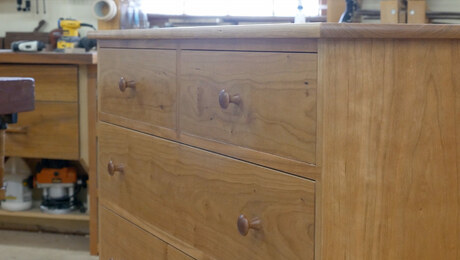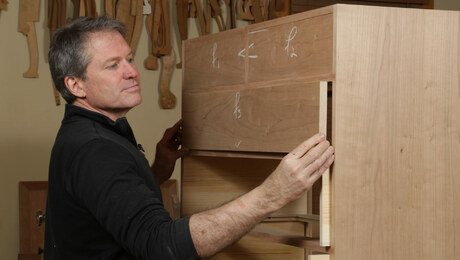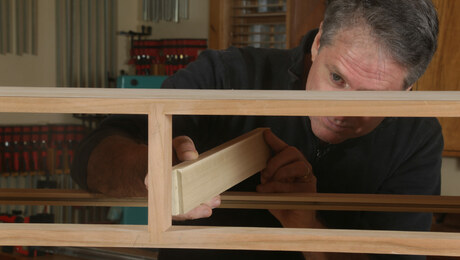A smart way to create dovetailed dividers
In this master class episode, Tom McLaughlin finishes the construction of the case for the Shaker dresser, creating the front and back dividers and eventually gluing up the case.Sponsored by Lee Valley/Veritas
The drawer dividers on this Shaker dresser will be joined and fitted using exposed sliding dovetail joinery. It all starts with a homemade jig that guides a router equipped with a 5/8-in. guide collar and a 3/4-in.-wide 14° dovetail bit. This simple jig made of plywood makes cutting the sliding dovetail slots efficient and accurate by referencing off the bottom and front of one side of each side panel, and then flipping it to reference off the bottom and back of the other side of the panel. This creates perfectly aligned and parallel dovetail slots at 90° to the front. A second dovetail jig is used to cut the singular center dovetail slots for the vertical divider that separates the top opening into two drawer openings.
With the slots cut, the case can now be dry-assembled and the drawer dividers determined and cut to length. Once the dividers are cut to length, the ends of all the dividers are cut on the router table, holding vertically against the fence, using the same dovetail bit used to cut the sliding dovetailed slots.
After a dry-fit, the case sides, top, and bottom are glued up, checking for square by measuring and adjusting until the diagonals are equal, or by using a squaring stick.



























Comments
Great episode - thanks so much!
What did Barry say about the glue brush? He doesn't like blue things?
Great video as usual. See you on SNL.
I love glue brushes. I even have a few of ones just like Tom's. His is just old and weathered. It looks like it has a few stories to tell.
I am curious what kind of glue was being used?
Pre ordered plans arrived today. Can’t wait to get started.
It was nice to see them have it not square when clamping, then fix it. Like most of us do, or maybe it really is just me. Thoroughly enjoying this series!
Tom, I am a hobby woodworker hoping to become a fine woodworker. In this video you used a 3/4" dovetail router bit with a 5/8" guide collar. I am assuming you had a 1/4" shaft on the dovetail router bit. With this I shopped for router bits and came to the conclusion a 1/2" bit shaft together with a 3/4" top bearing could work very well, with the view that one would not need to take two router passes on each drawer divider. Your comments?
Log in or create an account to post a comment.
Sign up Log in